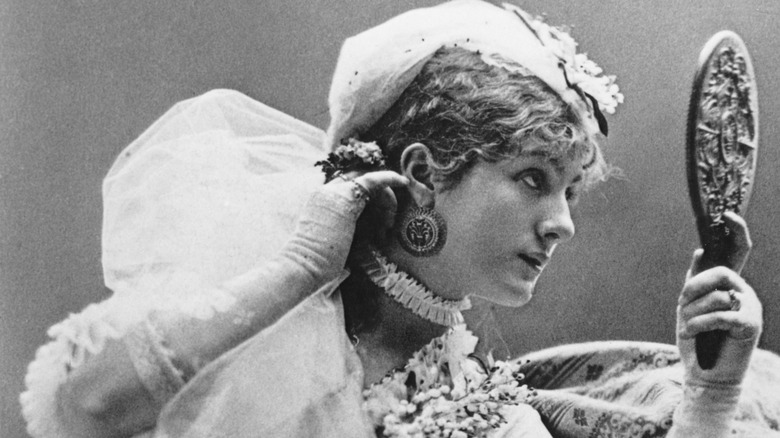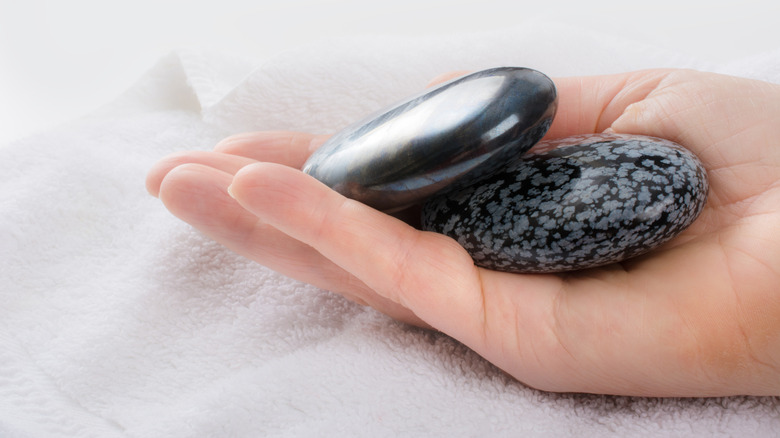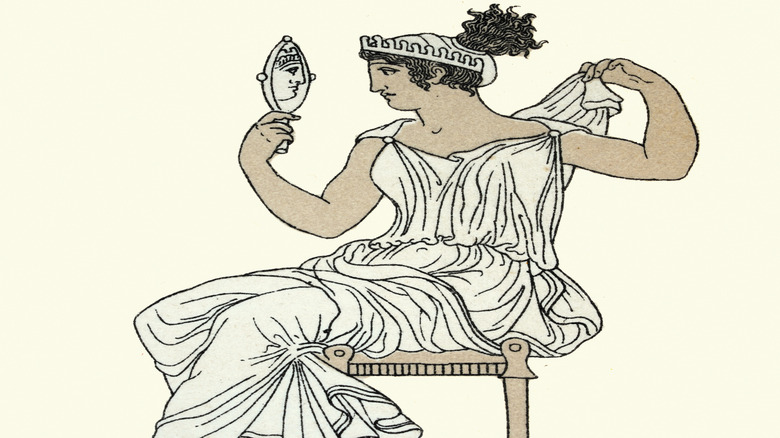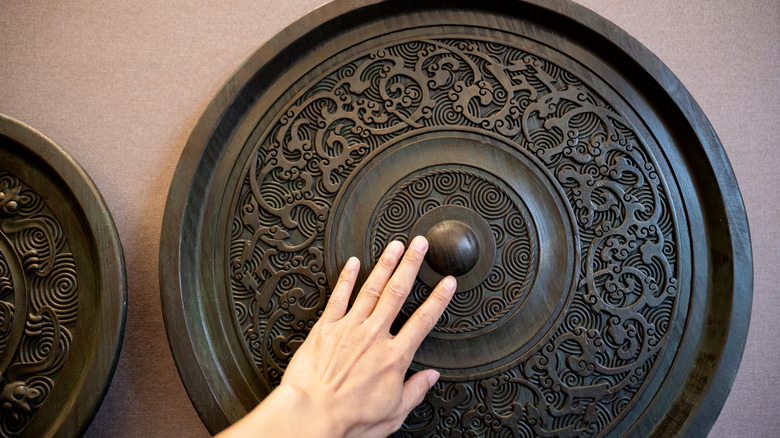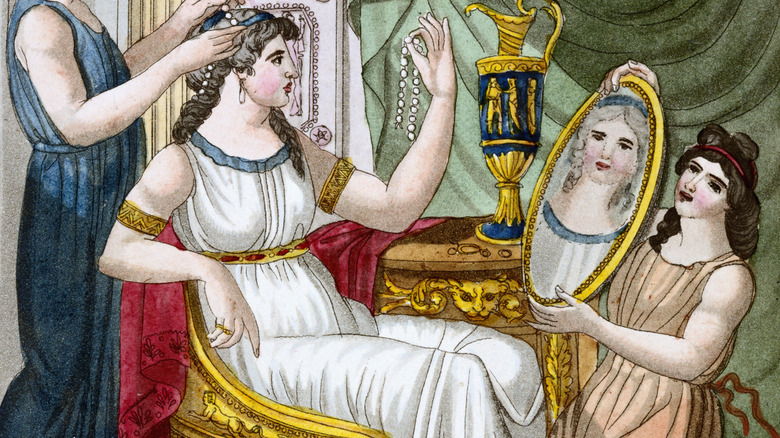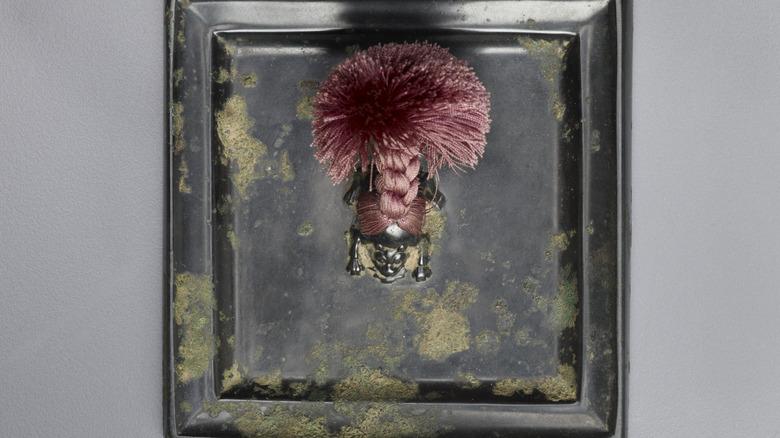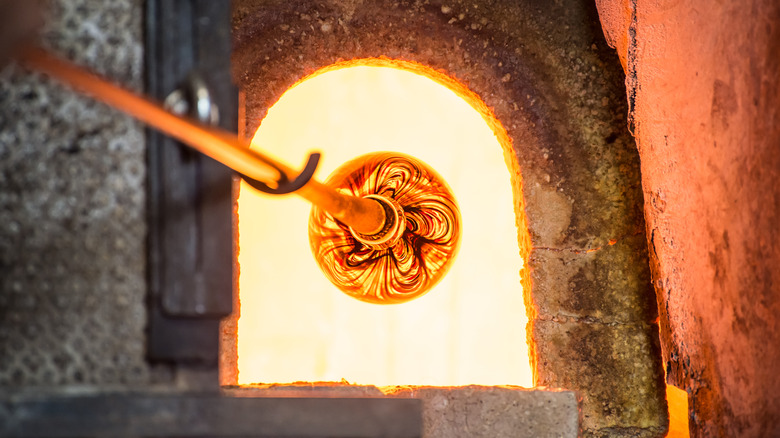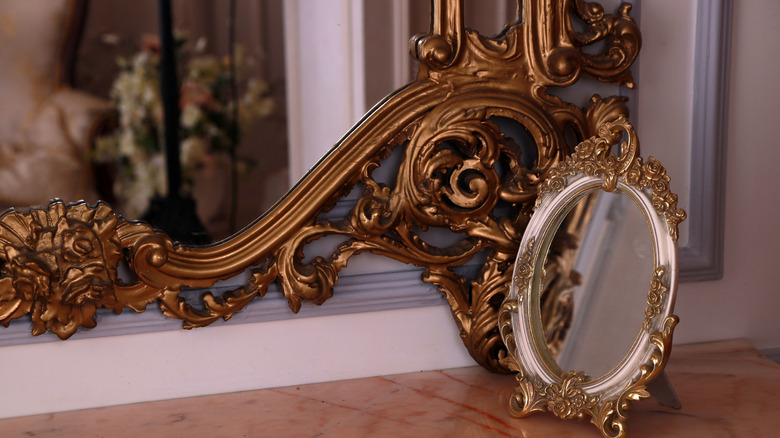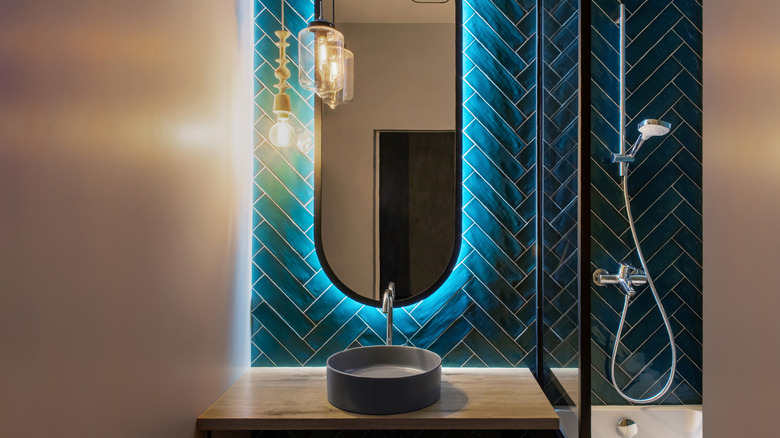Here's When Mirrors Were Invented And How They Were Made Throughout History
Mirrors are arguably one of the most common items you might come across on a day-to-day basis. Today, these items are in virtually every bathroom, and some people also have decorative mirrors in other areas of their homes. Mirrors are key safety measures when driving a vehicle, and you might even notice mirrors in other places throughout your daily life, such as stores, your workplace, and your favorite restaurant or coffee shop. Some types are even used in research devices, such as microscopes and telescopes. On top of this, you might have a handheld mirror in your purse or bag.
Given their ubiquity, it is easy to take all the uses of mirrors for granted. It's also common to assume these are relatively new inventions in human history. However, the invention of the mirror dates back thousands of years, and they have undergone numerous changes as humans perfected these reflective devices. For example, silvered mirrors, which inspired the types of mirrors commonplace today, date back to the 19th century. It is worth taking a look at the other major milestones mirror technology has undergone throughout human history — you may also be surprised to learn how different parts of the world were involved.
Stones served as the world's first mirrors
While there is some debate on the exact timeline, researchers believe some of the world's first mirrors date back to approximately 4000 B.C. However, these mirrors were not the reflective glass and metal items humans use today. Instead, these "mirrors" actually consisted of obsidian stones. It's also worth noting that obsidian stones served as materials for other important early human inventions, such as spears and arrowheads.
These black-colored volcanic stones do not possess reflective qualities all on their own, though. To make obsidian into mirrors, the stones underwent a thorough polishing process to help reveal their natural reflective qualities. Today, obsidian is also nicknamed the "mirror stone." While no longer used for mirrors, the stones still serve important aesthetic, cultural, and spiritual purposes. Obsidian stones can now be found anywhere in the world where there are certain dome-shaped types of volcanoes, such as those in certain parts of the western United States.
Hand mirrors were invented in ancient Greece
When you think about the types of items that were invented in ancient Greece, it's possible that mirrors do not automatically come to mind. However, researchers do believe that some of the world's first handheld mirrors date back to the fifth century B.C. In fact, fifth-century pottery drawings and paintings from Greece depict humans looking into these types of mirrors. Archeologists also believe this is the earliest evidence of humans using mirrors for self-grooming purposes.
Still, despite their use in grooming, these small ancient Greek mirrors were not constructed with any glass like today's compact mirrors. Instead, these early hand-held mirrors were made with polished metal, such as copper, and then attached to handles for easy use. The invention of this metal handheld mirror also presented some apprehension for those who believed in Greek mythology and superstitions. In particular, one ancient Greek myth tells the story of a boy named Narcissus, who was became a flower out of punishment for falling in love with his own reflection. (Interestingly, the term "narcissist" was later coined in 1889 by psychiatrist Paul Nacke.) This became a cautionary tale to the Greeks who used mirrors for tools of self-knowledge, but who also wanted to avoid looking into their reflections for vanity's sake.
Bronze mirrors were found throughout ancient civilizations
While it is thought that the ancient Greeks constructed their handheld mirrors with the use of pure copper, bronze was another metal used in early mirrors. Among those who utilized the characteristics of bronze metals for mirrors were ancient Egypt, China, and Japan, all between 2900 B.C. and 300 A.D. First, the Egyptians were thought to have created bronze-containing mirrors starting around 2900 B.C. These were shaped as discs to help represent the sun god Ra (Re). Bronze mirrors were also constructed in China around 2000 B.C.
From there, bronze mirrors were imported from China to Japan around 300 A.D. Like the Egyptians, the Japanese also considered mirrors as sacred ornaments, rather than only as tools for grooming. During the medieval era, the Japanese would use these bronze mirrors to help ward off evil spirits, and they were even sometimes used in exorcism ceremonies. What's more, bronze mirrors were also thought to symbolize power, and they were often put on display around temples, tombs, and shrines alike. Some also believed the sun goddess of Amaterasu sent mirrors to Earth as a way for a divine few to connect with the sun.
Ancient Romans introduced mirrors made with silvering techniques
Bronze and copper-containing mirrors were created in numerous ancient civilizations across the world, including in ancient Rome to some degree. However, the Romans also started evolving their mirror-making techniques by including silvered metals to create glass instead of relying on bronze or copper. These became commonplace around 1500. Also nicknamed "silvering," this technique used more reflective metals, such as a tin-mercury amalgam. This tin-mercury amalgam was later widely used between the 1500s and early 1900s, but these mirrors also became both health and environmental dangers when they shattered and released mercury in vapor and liquid form.
Not only were the ancient Romans credited for silvered glass mirror-making, but these changes were also significant in terms of usability. While bronze and copper mirrors could still provide reflections of those who used them, these were often distorted. Also, bronze and copper mirrors were more vulnerable to tarnishing than silvered metal. One example is the effects of oxidation on copper, which can lead to discoloration. What's more, like mirrors in other ancient civilizations, the Romans may have connected these items to both affluence and spirituality, associating them with deities including Venus, the goddess of love.
Early versions of glass mirrors became more commonplace around 500 A.D.
Other early attempts at glass mirrors may be traced back to the third century A.D. At this point, humans used glassblowing techniques to create multiple layers of colored glass tiles, lead, and other metals. The end result was sort of a mess, to say the least. While perhaps decorative, these attempts at glass mirrors were not considered very reflective or reliable.
However, around 500 A.D., it is thought that the silvered tin-mercury amalgam originally used in ancient Rome was being implemented by other civilizations, too. The silvered mercury was prized for a much clearer reflection, and the technique found its way to areas east of Europe, such as China. Aside from Roman silvering techniques, people in other parts of the world were experimenting with glass mirror making as well. This includes the Middle East during an era that is known as the Islamic Golden Age, which started in the eighth century. During this time, artisans discovered ways to combine melted metal and glass to create more uniform mirrors that were also much more reflective.
Venice became the epicenter of the modern glass mirror
Silvered metal mirrors were first invented in ancient Rome, while other glass versions were made centuries later in other parts of the world. Between the 13th and 15th centuries, Italy revolutionized mirror making once again. This time, mirror evolution was taking place in Venice, rather than Rome. Here, they created a clear glass called "cristallo," which was a huge step in the evolution of the mirror because it offered the best reflection yet.
Venetian mirrors consisted of four layers: glass, tin foil, mercury, and then a final glass layer. Not only did these layers improve the reflectiveness of the product, but they also significantly improved the durability of the mirrors overall. This refined process set the stage for modern glass mirror making, and production spread throughout the rest of the world. Also, thanks to these innovations, mirror production was a key component of the Venetian economy for hundreds of years. At the time, though, mirrors were still primarily used by the affluent due to their high cost. As such, most of Venice's mirror customers consisted of royal families and the wealthy bourgeoisie throughout Europe. The business of Venetian mirror-making also had its dark side, however, as the guildsmen were threatened with death if they told any outsiders about how these mirrors were crafted.
The modern-day glass mirror became more commonplace in the 1800s
After the Venetians began making more durable and reflective mirrors around 1200 A.D., these mirror-making techniques eventually spread to other parts of Europe. It is thought that the modern-day glass mirror comes from French manufacturers during the latter part of the Industrial Revolution. Then, in 1835, silvered-glass mirrors were perfected in Germany by a chemist named Justus von Liebig. Rather than using the mercury or crystal glass of the past, von Liebig used metallic silver on top of a layer of clear glass.
Evolving mirror production also meant decreased prices, thereby making these items more affordable for the middle class. Starting with the Industrial Revolution, mirrors were no longer considered exclusive to the upper classes. The invention of indoor plumbing also led to bathrooms in homes, with mirrors following suit. Rather than being in handheld form only, mirrors were now hung up on walls as functional pieces, rather than merely for aesthetics or signs of wealth. At the time, it was common for a standard mirror, or plane mirror, in a bathroom to have no frame, with more decorative options emerging later in the 20th century.
Today's mirrors are often made with the help of aluminum
Modern-day mirrors are constructed with most of the techniques perfected during the Industrial Revolution. While still technically fragile, today's mirrors are much more durable than their counterparts from hundreds (and thousands) of years ago. Also, while silvering is still a common practice, manufacturers no longer use silver nitrate because of its possible combustible byproduct of ammonium nitrate. Another problem with silvered glass is it can still tarnish when water is left on the mirror.
An additional evolutionary piece to mirror making is the use of aluminum coatings. You may be familiar with aluminum's physical and chemical properties, which have made this element useful in the manufacturing of numerous everyday products. When considering mirrors, not only can aluminum help protect the glass and prevent tarnishing, but it is also considered the most reflective material. In theory, aluminum can still tarnish. However, mirror manufacturers avoid this by applying aluminum powder onto cooled glass before sealing it up with a protective coating of paint. There are also new techniques used in making professional-grade mirrors. For added durability, manufacturers use a combination of boron and silica to help prevent the glass from breaking when exposed to heat.
